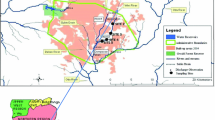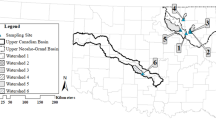Abstract
Recreational water quality of rivers is typically assessed by microbial analysis of indicator organisms, such as Escherichia coli and enterococci in samples collected directly from the water column, implying that risk to public health comes from free-floating microorganisms. In New Zealand, the Recreational Water Quality Guidelines apply certain E. coli concentration thresholds to categorize results into ‘meet guidelines’ (≤ 260 cfu E. coli 100 mL−1), ‘alert level’, and ‘action level’ (≥ 550 cfu E. coli 100 mL−1). The impairment of water quality due to re-suspended riverbed sediment under flood conditions has been widely recognized. However, the potential risks posed by sediment-linked microorganisms associated with river recreational activities under base flow are less appreciated. We evaluated the water quality of 30 rivers in Canterbury, New Zealand, during base flow conditions prior to and after artificially stirring the sediment. Bacterial and protozoan indicators, pathogens, water quality, and land use in surrounding areas were examined. While 71% of water samples (n = 64) met New Zealand Recreational Water guidelines prior to stirring, only 39% of samples (n = 35) met the guidelines after stirring. E. coli levels increased by 110%, or more, following sediment stirring. Campylobacter were detected in every river, at least once, and increases were observed following stirring. We conclude that sediment-associated microbes become suspended by recreational activities and may pose a higher risk than previously thought to river users. To ensure public health is protected, authorities should assess microorganisms in both sediment and water samples to rate the microbiological risk of recreational water use.
Highlights
-
River sediment can contain substantial levels of indicator bacteria.
-
Sediments may also contain pathogens including Campylobacter and Cryptosporidium.
-
Stirring up sediment during recreational activities may present increased public health risk.
-
Both water and sediment should be analyzed to fully assess microbial water quality.



Similar content being viewed by others
Data availability
The authors declare that the data supporting the findings of this study are available within the paper, its supplementary information files, and on request from the authors.
Abbreviations
- cfu:
-
Colony forming unit
- GIS:
-
Geographic information system
- MPN:
-
Most probable number
- TSS:
-
Total suspended solids
References
Anderson KL, Whitlock JE, Harwood VJ (2005) Persistence and differential survival of fecal indicator bacteria in subtropical waters and sediments. Appl Environ Microbiol 71:3041–3048
Ashbolt NJ, Grohmann GS, Kueh C (1993) Significiance of specific bacterial pathogens in the assessment of polluted recieving waters of Sydney. Water Sci Technol 27:449–452
Ballantine D, Booker D, Unwin M, Snelder T (2010) Analysis of national river water quality data for the period 1998–2007. National Institute of Water and Atmospheric Research Client report, CHC2010–038. p. 61p.
Bell RL, Kase JA, Harrison LM, Balan KV, Babu U, Chen Y, Macarisin D, Kwon HJ, Zheng J, Stevens EL, Meng J (2021) Brown EW (2021) The Persistence of Bacterial Pathogens in Surface Water and Its Impact on Global Food Safety. Pathogens 10(11):1391. https://doi.org/10.3390/pathogens10111391. (PMID: 34832547; PMCID: PMC8617848)
Bolwell CF, Gilpin BJ, Campbell D, French NP (2015) Evaluation of the representativeness of a sentinel surveillance site for campylobacteriosis. Epidemiol Infect 143(09):1990–2002
Braeye T, DE Schrijver K, Wollants E, van Ranst M, Verhaegen J. (2015) A large community outbreak of gastroenteritis associated with consumption of drinking water contaminated by river water, Belgium, 2010. Epidemiol Infect. 143:711-9. https://doi.org/10.1017/S0950268814001629
Burton GA, Gunnison D, Lanza GR (1987) Survival of pathogenic bacteria in various freshwater sediments. Appl Environ Microbiol 53: 633-638
Chaban B, Musil KM, Himsworth CG, Hill JE (2009) Development of cpn60-based real-time quantitative PCR assays for the detection of 14 Campylobacter species and application to screening of canine fecal samples. Appl Environ Microbiol 75:3055–3061
Davies CM, Long JA, Donald M, Ashbolt NJ (1995) Survival of fecal microorganisms in marine and freshwater sediments. Appl Environ Microbiol 61:1888–1896
Devane ML, Moriarty EM, Wood D, Webster-Brown J, Gilpin BJ (2014) The impact of major earthquakes and subsequent sewage discharges on the microbial quality of water and sediments in an urban river. Sci. Total Environ. 485–486C: 666–680.
Eaton AD, Clesceri LS, Rice EW, Greenberg AE (2005) Standard Methods for the Examination of Water and Wastewater. 21st Edn, American Public Health Association (APHA) Press, Washington, DC.
Environment Agency (2004) The Microbiology of Drinking Water (2004) – Part 6 – Methods for the isolation and enumeration of sulphite-reducing clostridia and Clostridium perfringens by membrane filtration. Methods for the Examination of Waters and Associated Materials. In: E. Agency, editor Environment Agency, Bristol, England.
Feris K, Ramsey P, Frazar C, Rillig M, Gannon J, Holben W (2003) Structure and seasonal dynamics of hyporheic zone microbial communities in free-stone rivers of the western United States. Microb Ecol 46:200–215
Fish JT, Pettibone GW (1995) Influence of freshwater sediment on the survival of Escherichia coli and Salmonella sp. as measured by three methods of enumeration. Lett Appl Microbiol 20:277–281
Gillespie IA, O’Brien SJ, Frost JA, Adak GK, Horby P, Swan AV et al (2002) A case-case comparison of Campylobacter coli and Campylobacter jejuni infection: a tool for generating hypotheses. Emerg Infect Dis 8:937–942
Griebler C, Lueders T (2009) Microbial biodiversity in groundwater ecosystems. Freshw Biol 54:649–677. https://doi.org/10.1111/j.1365-2427.2008.02013.x
Haller L, Amedegnato E, Poté J, Wildi W (2009a) Influence of freshwater sediment characteristics on persistence of fecal indicator bacteria. Water Air Soil Pollut 203:217–227. https://doi.org/10.1007/s11270-009-0005-0
Haller L, Poté J, Loizeau J-L, Wildi W (2009b) Distribution and survival of faecal indicator bacteria in the sediments of the Bay of Vidy, Lake Geneva, Switzerland. Ecol Ind 9:540–547. https://doi.org/10.1016/j.ecolind.2008.08.001
Ministry of Health (MoH) and Ministry for the Environment (MfE) (2003) Microbiological water quality guidelines for marine and freshwater recreational areas. Wellington, New Zealand
Jagals P, Grabow WOK, de Villiers JC (1995) Evaluation of indicators for assessment of human and animal faecal pollution of surface run-off. Water Sci Technol 31:235–241. https://doi.org/10.1016/0273-1223(95)00272-O
Jamieson R, Joy DM, Lee H, Kostaschuk R, Gordon R (2005a) Transport and deposition of sediment-associated Escherichia coli in natural streams. Water Res 39:2665–2675
Jamieson R, Joy DM, Lee H, Kostaschuk R, Gordon RJ (2005b) Resuspension of sediment-associated Escherichia coli in a natural stream. J Environ Qual 34:581–589
Karimaee-Tabarestani M, Zarrati AR (2015) Sediment transport during flood event: a review. Int J Environ Sci Technol 12:775–788
Muirhead RW, Davies-Colley RJ, Donnison AM, Nagels JW (2004) Faecal bacteria yields in artificial flood events: quantifying in-stream stores. Water Res 38:1215–1224
Nagels J, Valstar ER, Stokdijk M, Rozing PM (2002a) Patterns of loosening of the glenoid component. J Bone Joint Surg Br 84:83–87
Nagels JW, Davies-Colley RJ, Donnison AM, Muirhead RW (2002b) Faecal contamination over flood events in a pastoral agricultural stream in New Zealand. Water Sci Technol 45:45–52
Obiri-Danso K, Jones K (1999) Distribution and seasonality of microbial indicators and thermophilic campylobacters in two freshwater bathing sites on the River Lune in northwest England. J Appl Microbiol 87:822–832
Oliver DM, Clegg CD, Heathwaite AL, Haygarth PM (2007) Preferential attachment of Escherichia coli to different particle size fractions of an agricultural grassland soil. Water Air Soil Pollut 185:369–375. https://doi.org/10.1007/s11270-007-9451-8
Pachepsky YA, Shelton DR (2011) Escherichia Coli and Fecal Coliforms in Freshwater and Estuarine Sediments. Crit Rev Environ Sci Technol 41(12):1067–1110. https://doi.org/10.1080/10643380903392718
Pote J, Haller L, Kottelat R, Sastre V, Arpagaus P, Wildi W (2009) Persistence and growth of faecal culturable bacterial indicators in water column and sediments of Vidy Bay, Lake Geneva, Switzerland. J Environ Sci 21:62–69
Quinn JM, Cooper AB, Davies-Colley RJ, Rutherford JC, Williamson RB (1997) Land use effects on habitat, water quality, periphyton, and benthic invertebrates in Waikato, New Zealand, hill-country streams. NZ J Mar Freshwat Res 31(5):579–597. https://doi.org/10.1080/00288330.1997.9516791
Rzeżutka A (2004) Cook N (2004) Survival of human enteric viruses in the environment and food. FEMS Microbiol Rev 28(4):441–453. https://doi.org/10.1016/j.femsre.2004.02.001
Staley ZR, Chase E, Mitraki C, Crisman TL, Harwood VJ (2013) Microbial water quality in freshwater lakes with different land use. J Appl Microbiol 115:1240–1250. https://doi.org/10.1111/jam.12312
Stelma GN Jr (2018) Use of bacterial spores in monitoring water quality and treatment. J Water Health 16(4):491–500. https://doi.org/10.2166/wh.2018.013
Till D, McBride G, Ball A, Taylor K, Pyle E (2008) Large-scale freshwater microbiological study: rationale, results and risks. J Water Health 6:443–460. https://doi.org/10.2166/wh.2008.071
Tran NH, Gin KY-H, Ngo HH (2015) Fecal pollution source tracking toolbox for identification, evaluation and characterization of fecal contamination in receiving urban surface waters and groundwater. Sci Total Environ 538:38–57. https://doi.org/10.1016/j.scitotenv.2015.07.155
van Bunnik A, Pollock A, Somerset E, Francke J, Fyfe J, Preston J, et al. (2007) Environment New Zealand 2007. Ministry for the Environment, Publication No ME 847
Walters E, Katzl K, Schwarzwalder K, Rutschmann P, Mueller E, Horn H (2014) Persistence of fecal indicator bacteria in sediment of an oligotrophic river: comparing large and lab-scale flume systems. Water Res 61C:276–287
Vanden Esschert KL, Mattioli MC, Hilborn ED, Roberts VA, Yu AT, Lamba K, Arzaga G, Zahn M, Marsh Z, Combes SM, Smith ES, Robinson TJ, Gretsch SR, Laco JP, Wikswo ME, Miller AD, Tack DM, Wade TJ, Hlavsa MC (2020) Outbreaks Associated with Untreated Recreational Water - California, Maine, and Minnesota, 2018–2019. MMWR Morb Mortal Wkly Rep 69:781–783. https://doi.org/10.15585/mmwr.mm6925a3
van Donsel DJ, Geldreich EE (1971) Relationships of salmonellae to fecal coliforms in bottom sediments. Water Res 5(11):1079–1087
Warhurst DC (1999) Isolation and identification of Cryptosporidium oocysts and Giardia in waters. Environment Agency.
Wentworth CK (1922) A Scale of Grade and Class Terms for Clastic Sediments. J Geol 30:377–392. https://doi.org/10.1086/622910
Wilcock RJ, Monaghan RM, Quinn JM, Campbell AM, Thorrold BS, Duncan MJ et al (2006) Land-use impacts and water quality targets in the intensive dairying catchment of the Toenepi stram, New Zealand. NZ J Mar Freshwat Res 40:123–140
Wong T, Devane M, Hudson JA, Scholes P, Savill M, Klena J (2004a) Validation of a PCR method for Campylobacter detection on poultry packs. Br Food J 106:642–650
Wong T, Whyte RJ, Cornelius AJ, Hudson JA (2004b) Enumeration of Campylobacter and Salmonella on chickens packs Br. Food J 106:651–662
Yakirevich A, Pachepsky YA, Guber AK, Gish TJ, Shelton DR, Cho KH (2013) Modeling transport of Escherichia coli in a creek during and after artificial high-flow events: three-year study and analysis. Water Res 47:2676–2688. https://doi.org/10.1016/j.watres.2013.02.011
Acknowledgements
The authors wish to thank staff at ESR, in particular Margaret Mackenzie for laboratory technical assistance, Dr David Wood for statistical advice and assistance, Dr Craig Billington, Dr Beverley Horn, and Dr Joanne Kingsbury for providing valuable comments.
Funding
This work was funded by Ministry of Business, Innovation and Employment under Contract No. C10X1006.
Author information
Authors and Affiliations
Corresponding author
Ethics declarations
Conflict of interest
On behalf of all authors, the corresponding author states that there is no conflict of interest.
Supplementary Information
Below is the link to the electronic supplementary material.
41742_2023_557_MOESM1_ESM.docx
Supplementary file1 Detailed information of each sampling site is provided in Table S1 in the supplemental material, including the sediment composition of all 30 rivers and the land use in the immediate vicinity of each sampling site (within a 1 km radius), determined using ArcGIS (DOCX 29 KB)
Rights and permissions
Springer Nature or its licensor (e.g. a society or other partner) holds exclusive rights to this article under a publishing agreement with the author(s) or other rightsholder(s); author self-archiving of the accepted manuscript version of this article is solely governed by the terms of such publishing agreement and applicable law.
About this article
Cite this article
Pattis, I., Moriarty, E., Anderson, J. et al. Recreational Disturbance of River Sediments During Base Flow Deteriorates Microbial Water Quality. Int J Environ Res 18, 6 (2024). https://doi.org/10.1007/s41742-023-00557-3
Received:
Revised:
Accepted:
Published:
DOI: https://doi.org/10.1007/s41742-023-00557-3




